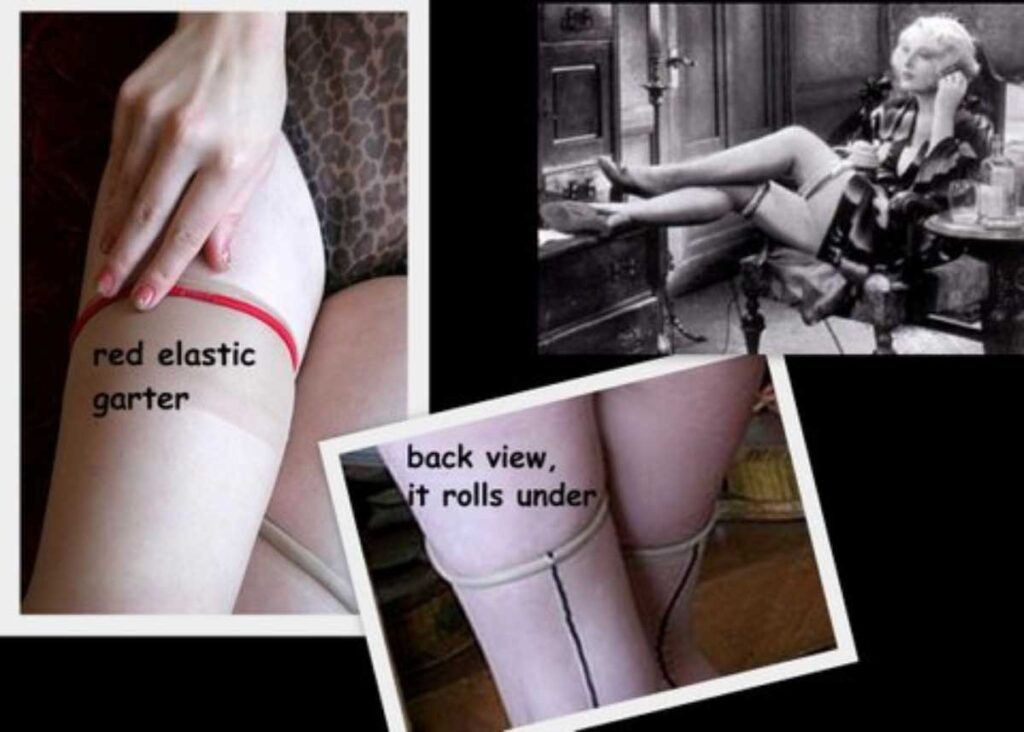
Flappers in the 1920s wore stockings, rolled down to below the knee. They used roll garters to keep them up before stretch nylon was invented. Here’s a vintage roll garter and how to wear it.
It began with the flappers, but here’s how to wear it today.
What are Rolled Stockings?
In the early 1920s, some women rolled down their thigh-high stockings to different lengths. They did this either mid-thigh or just below the knee. The look was popular in warm weather. Rolled stockings were worn with bathing suits.
The flapper style became trendy. The girl in the photo is showing off the look, with rolled down stockings revealing some skin.
The photo was taken in 1922, in Idaho.
Roll Garters
Roll garters, on the left, are elastic bands with fabric to hold up stockings. In the 1920s, stockings were made from silk – a fabric that doesn’t stretch or stay up on its own. Some type of garter had to be worn, since nylon stockings weren’t invented yet.
Women put on roll garters over stockings. They rolled down the stocking top over the garter. The thicker the roll looked, the more stylish it was considered to be. Several patents for roll garters were filed in the 1920s and 30s. They varied in thickness and materials used.
How They Became So Trendy
Women in the 1920s often wore thigh-high stockings with garter straps. The garter straps attached to a long, corset-like girdle covering the hips. And up until the 1920s, women were completely covered. The knees were seen as immoral dress. Kathleen Morgan Drowne and Patrick Huber wrote this book in The 1920s.
The rolled stocking trend caught on anyway. Young women rebelled against garter straps by wearing rolled stockings. And fashion was changing – dress styles were becoming shorter and less form-fitting.
Rolling down your stockings must’ve felt so “freeing.” (And must’ve made it so much easier to dance the Charleston.) The trend was so popular by the late 1920s that there was even a movie, Rolled Stockings. It was a silent film made in 1927 that starred Louise Brooks. Check out this fun movie poster, where you can clearly see the “roll.”
Where To Get Them
Some vintage fashion fans find modern rolled stockings unsatisfactory. The knee-high by Fogal is an example. If you want the real thing, I found the vintage roll garters above on Etsy, in the shop Subterranean Vintage. (And isn’t the retro package design so cool?)
Different styles of vintage roll garters were available in various Etsy shops. I found several options during my last check.
Modern Day Roll Garters – They’re Back?
I was surprised to find the lingerie brand reinvented the roll garter. This is the modern version.
The elastic roll garter is at Dollhouse Bettie.

Roll Garters, Re-Invented for Retro Lingerie Fans
Dollhouse Bettie’s roll garter is a modern version. It is made from soft nylon/spandex elastic. This lingerie brand sells many retro-inspired styles.
This roll garter is not as wide as authentic vintage roll garters, so it won’t look very rounded on your leg. Instead, it looks like a small roll, which I think is more flattering.
But, it still has that retro vibe. It will fit anyone perfectly. You can wear it below your knee or higher on your thigh. It comes in 5 sizes.
How to Wear It
The photos above demonstrate how the garter looks when you put it on over your stockings. Afterward, show how it should appear when the top of your stockings is rolled over it.
I’m unsure how well this roll garter will hold up authentic vintage stockings. The non-nylon ones tend to fall down. (Modern nylons are so much more practical, anyway!)
The roll garter will look fabulous with thigh highs that have a back seam. Dollhouse Bettie sells similar ones in the photo. Look for styles without lace at the top, because thigh highs that are plain will “roll” the best.
Suggested Reading:
Iskra Banović is our seasoned Editor-in-Chief at Blufashion. She has been steering the website’s content and editorial direction since 2018. With a rich background in fashion design, Iskra’s expertise spans across fashion, interior design, beauty, lifestyle, travel, and culture.




